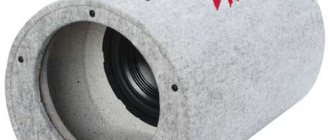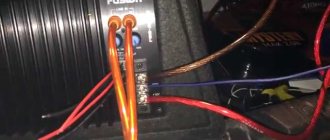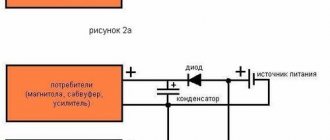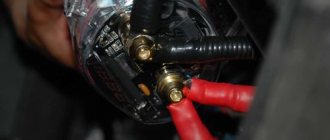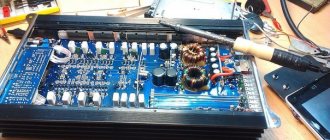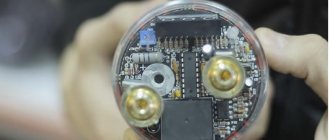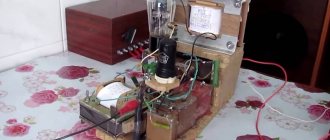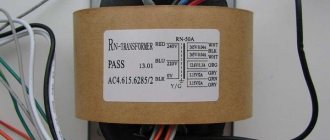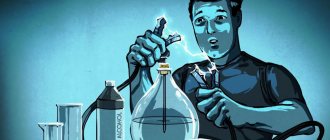A storage device, storage capacitor or capacitor is an electrical element consisting of two electrodes (plates) separated by insulating material. This device has the property of accumulating electrical energy and delivering it to the consumer. The amount of energy that the element can accumulate depends on the area of the electrodes. This parameter is called the capacitance of the capacitor. In high-quality automotive audio systems, a large-capacity electrical device is connected parallel to the amplifier's power terminals. Why you need a drive and how to connect a capacitor to a subwoofer is the topic of this article.
How to connect a storage capacitor to a subwoofer
Car enthusiasts often ask why an additional power supply system is needed. A car subwoofer, when playing a low-frequency signal at peak power, consumes a current that no battery can provide. To the ear, this is perceived as “dips” in the sound, and if the high current consumption is constant, then the sound becomes “booming.” The electrical capacitance performs the function of accumulating charge, which is transferred to the power circuit of the low-frequency amplifier.
This method of powering the amplifier, even in inexpensive systems, significantly improves the sound quality. High-power speaker systems require a lot of energy, so without a storage unit the sound will be of low quality. This is especially noticeable at night, when the number of electricity consumers in the car increases. The battery “sags”, the headlights begin to blink, and the clear bass sound becomes “blurry” and unpleasant to the ear. Often, a drop in the amplifier supply voltage leads to clipping, that is, to a two-way limitation of the signal amplitude. This phenomenon can damage the speakers.
The energy-storing device in the power circuit has low internal resistance, so it quickly releases the stored energy and precisely at the moment when the amplifier does not have enough energy for normal operation. Connecting the device to the amplifier must be carried out according to certain rules.
Ionistors
Ionistors are fashionable substitutes for storage devices, something that most music lovers often carry in the trunk; they differ from capacitors in the following parameters:
- Large energy losses
- Huge resistance
- They release charge much slower than drives
- They cost several times less than drives of the same capacity
- The optimal operating time of the ionistor is: 1 second/83 cool.
Checking the ionistor
The instructions recommend checking the ionistor to understand whether it works and how it works:
- Connect the ionistor to the speaker system with power drawdowns
- Start the engine and observe, if the voltage at its terminals increases, then everything is in order for now
- Increase the volume and notice how the voltage drops from 13 to 10 volts
- Car audio enthusiasts call this situation a drawdown; it can become much greater if you use thin and low-quality wires made of cheap copper-plated aluminum in the power system.
- In this case, the cable sag is added to the standard sag.
And the faster and more the user wants to take energy through the cable, the more the cable will interfere with this (especially if it is thin and very long). The problem from a cheap and low-quality cable is reflected in the ionistor, which, after discharge, will no longer be able to accumulate energy again, so decide for yourself
Installing a capacitor for a subwoofer
Modern energy storage elements are not just an energy storage device, but a complex electronic device. The device body contains a chip that measures DC voltage at the terminals of an electrical device. Behind the transparent cover there is a four-digit LED indicator, by which this voltage can be controlled. How to connect the drive to an amplifier and subwoofer. In practice, nothing is connected to the woofer or speaker, and the storage device must be connected to the power terminals of the low-frequency amplifier, strictly observing the polarity. The terminals of the device are marked “+” and “-”, which must match the similar markings on the amplifier body.
The connection diagram for the subwoofer drive is very simple and can be implemented independently. The connecting wires can be clamped under the power terminal screw or an adapter block can be used for this purpose. In order to avoid the influence of connecting cables on the discharge of the device, it should be placed as close as possible to the low-frequency amplifier. The length of the connecting wires should not exceed 30-40 cm. All power wires running from the battery to the device and further to the amplifier must have a large cross-section to prevent energy loss. Copper-clad steel wires cannot be used for this purpose. The cables must be multi-core and made of pure copper.
Types and applications
There are many ways to classify modern capacitors, which allow them to be grouped depending on the type of design, operating voltage, types of polarization and purpose, change in capacitance, and type of dielectric.
Types of polarization:
- ionic and ion-relaxation;
- volumetric;
- dipole-relaxation;
- electronic and electronic relaxation;
- spontaneous.
Based on the design features, there are tubular and cylindrical, monolithic, plate and sectional, disk, pot-shaped and cast, barrel, and sectional varieties.
Scope of application of capacitors:
- Electronics – radio and television equipment, storage devices, automation and various telemechanics, telegraphy and telephony.
- Electrical power engineering - discharge welding, starting electric motors, radio interference suppression, voltage regulation, electric lighting, energy extraction, use in complex circuits and generators, and voltage protection.
- Industry – mining, metallurgy and metalworking.
- Equipment – medical, laser, electrical measuring, radar, photographic, automotive.
Depending on the change in capacitance, there are constant, variable (the change is carried out mechanically or electrically) and tuning capacitors (the change is carried out one-time or periodically).
Installation and connection diagram of the storage capacitor to the subwoofer
Energy storage capacitors used in car subwoofers must have a capacity of 1 to 3 farads or more. In fact, some unscrupulous manufacturers produce products where the actual capacity is very different from the one indicated on the product body. Therefore, on forums you can often find complaints that installing an additional device did not produce any results. This is due to the fact that a counterfeit product was purchased. Therefore, the energy block for the amplifier should be purchased only in specialized stores. Very often, ionistors or super capacitors are sold in automotive markets as analogues of large-capacity capacitors.
Ionistors use porous plates that allow them to store a very large amount of energy, so the capacity of such devices is tens and hundreds of farads. Moreover, the voltage at which ionistors can operate without damage does not exceed 10 volts. The disadvantage of ionistors is their high internal resistance.
Basic Concepts
First, you need to understand what a container is and why it is needed, and what types it comes in. Anyone who has connected a capacitor has encountered this problem. If you decide to connect the container without certain knowledge, then your system will not work correctly, and, accordingly, proper high-quality power will not be provided.
This electrical element consists of two metal plates that are rolled into a tube. A dielectric is laid between them. Externally, it looks like a cylindrical element with two terminals.
Let us list the tasks that are assigned to a capacitor in an electrical circuit:
- Retaining charge for normal voltage.
- Retention of potential charge for a long time.
- In order to eliminate voltage surges, the current value must be within normal limits.
How to properly connect a subwoofer drive
Connecting a capacitor to an amplifier and subwoofer can be done when installing the entire sound system of a car or to an already working device. To separate the power circuit of the amplifier running on the amplifier from other consumers of electricity, a directly connected diode is placed between the positive of the battery and the energy storage unit. If you need to install the device on an already working set of equipment, then before starting work you should completely turn off the entire power system. It is believed that the capacity of the device is selected at the rate of 1 farad per kilowatt of power. A product of this capacity is the most common. For all amplifiers with lower power, a 1 farad drive is also suitable. Installation of the drive for the subwoofer is carried out using the mounting hardware that is included with the drive.
What to look for when purchasing?
The main thing that a car owner who wants to buy an electrolytic capacitor for a subwoofer should take into account is the ratio of its capacity and the power of the system. The rule is quite simple. The minimum limit is 650 to 850 µF per kilowatt. To simplify calculations, it is recommended to take 1F per 1 kW of sound system power.
It is ideal if a capacitor with a capacity exceeding the nominal values is installed in the car. Other features of a good element are as follows:
- The delivery kit should include everything you need to install the electrolytic capacitor in the machine. These include the wires that connect the amplifier, and special protected brackets that prevent damage to the element shell and the occurrence of other emergency situations;
- The pulse voltage of the capacitor should be 24 V. This is a sufficient reserve (the corresponding operating parameter of the on-board network is from 12 to 18 V) so that the drive does not overheat during charging;
- for a sharp release of high power and the formation of large currents, the capacitor must have powerful connectors with thick leads and a large area. Responsible companies offer products with gold-plated contacts;
- Charge indicators are a huge help, including for the convenience of monitoring the status of the drive during operation. This could be a simple circuit with a row of LEDs or a digital display;
- If you need a drive that you can simply connect and count on long-term stable operation, it is recommended to buy products equipped with a charge and condition monitoring system. Such models must be equipped with an indicator.
Read more: Automatic transmission does not shift gears: the main reasons for this malfunction
The last, but one of the main, remark: you should not save on buying an electrolytic capacitor for a subwoofer. On specialized forums you can find many examples, videos and photos of disassembling cheap products. They clearly and accurately show the discrepancy between the actual characteristics and the declared ones, and also describe the dangers of using this type of drive.
Before purchasing an electrolytic capacitor, you should definitely look for reviews on specialized resources. Or - look through the ratings and get acquainted with the characteristics of suitable products on the website of their manufacturers. Today, the mass market offers both electrolytic capacitors and ionistors that are quite sensitive to temperature fluctuations.
Installing a capacitor in the on-board network, in addition to purely utilitarian results in the form of stable operation of the speaker system, has several other advantages. In particular, current surges during operation of the ignition system are smoothed out. Also, the operating mode of the on-board generator improves, as it begins to experience less surges in consumption. And most importantly: the installed capacitor perfectly helps the starter work in winter, transferring power to the general network.
Is it possible to connect an ordinary capacitor to a subwoofer?
Of course, you can connect a regular capacitor to a subwoofer, but it will not give any effect. An electrolytic device with a capacity of 5,000-10,000 uF can act as a filter and reduce some electrical noise. For example, clicks will not be heard when you turn on any electrical equipment in the car. Even a large-capacity electrolyte battery will not be able to prevent voltage sags when playing powerful bass.
Only installing a storage capacitor for a subwoofer can provide the amplifier with energy when needed. If the amplifier is connected through the energy storage unit for the first time, the device needs to be charged. The same procedure must be performed when the battery has been removed from the car for a long time and the product is discharged.
To do this, the minus of the battery is connected to the minus of the device, and the plus is connected to the positive terminal of the device through a resistor with a nominal value of 10-20 Ohms and a power of 20 watts. Instead of a resistor, you can use a car light bulb. It will light up brightly at first, and as it charges, the glow will fade.
Top 5 devices of 2022
Based on consumer reviews, the 5 best capacitors for a subwoofer have been selected, showing good results and a long service life. These include products from well-known brands, suitable for use by both novice and experienced car audio engineers.
Kicx flc 1.5
pros
- good equipment
- contacts for ring terminals
- reverse polarity protection
- charge level indication
Minuses
- weight, dimensions
- capacity is only 1.5F
- low operating voltage margin
The main advantage of this capacitor is its complete ease of installation. Convenient complete brackets and a reliable contact group are provided. The product shows excellent service life thanks to electronic protection and a special mesh.
MD.Lab PC-E1.0
pros
- 1F capacity with small measurement error
- compact aluminum housing
- built-in voltmeter
Minuses
- no reverse polarity protection
- small margin for maximum voltage
- poor equipment (only capacitor)
This drive can only provide 18 V pulse voltage. If this is enough, the device will appeal to experienced audio system designers. The capacitor can operate at temperatures from -40 to 60 degrees Celsius and has low leakage currents.
ACV CAP-5.0F
pros
- overload protection
- protection against incorrect activation
- amplifier integration option
- possibility of connecting several series-connected load units
- advanced electronic parameter control system
- indicator light and built-in voltmeter
Minuses
- dimensions
- low pulse voltage value
- own connection diagram
- awkward terminal blocks
The most complete control of voltage and operating parameters available today, as well as the possibility of direct control from the amplifier are two striking features that distinguish this capacitor model. It will appeal to users who want to create a truly powerful system. A capacity of 5F is enough for acoustics of 5 kW.
Kicx DPC 2.0F
pros
- excellent power to size ratio
- built-in charge indicator
- Built-in shutdown relay in standby mode
- good surge voltage reserve
Minuses
- small area terminals
- poor equipment (only capacitor)
- low operating voltage 12V
This capacitor is very unpretentious. With some drawbacks, it allows overheating up to 95 degrees Celsius and will retain the charge when parked without the use of special connection circuits. The device will appeal to beginners; it is capable of delivering a 24V pulse.
Search data for your request:
What you need to know if you are planning to connect a capacitor in a car radio to audio devices such as a subwoofer or amplifier. What is a capacitor? Why do you need a capacitor for a subwoofer? What types of capacitors are there? If you don’t even ask such questions because you know what and why, then it’s not at all a fact that your capacitor is correctly connected to the car’s audio equipment, providing it with high-quality power.
Search data for your request:
Schemes, reference books, datasheets: Discussions, articles, manuals:
Wait for the search to complete in all databases. Upon completion, a link will appear to access the found materials.
WATCH THE VIDEO ON THE TOPIC: Capacitor, Prology 2 farad storage
